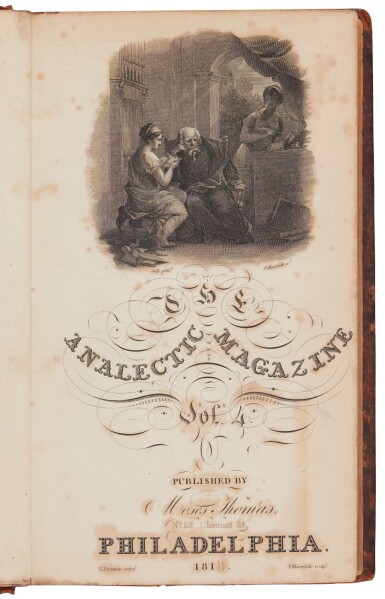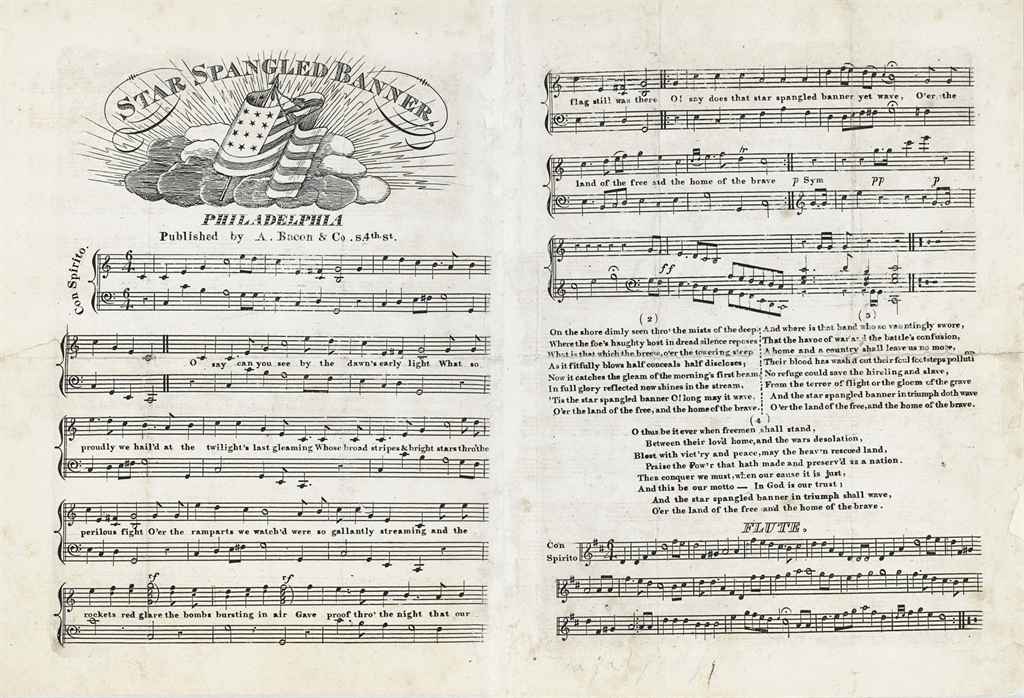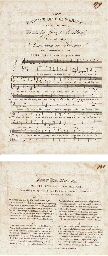Property from the Eric C. Caren Collection(STAR-SPANGLED BANNER) — FRANCIS SCOTT KEYAn Early Printing of the Star-Spangled Banner in The Yankee, Vol. III, No. 41. Boston: Rowe and Hooper, Friday, October 7, 1814 Large folio, 4 pages (19 1/2 x 13 in.; 495 x 330 mm) on a bifolium of wove paper, text in five columns; lightly browned, bit of foxing, disbound. The consignor has independently obtained a letter of authenticity from PSA that will accompany the lot. An early printing of what would become the nation's anthem In the first column of page 4, under the heading of "Poetry," the text of the "The Star-Spangled Banner" is printed along with the following explanatory text: "The annexed song was composed under the following circumstances—A gentleman had left Baltimore in a flag of truce, for the purpose of getting released from the British fleet, a friend of his who had been captured at Marlborough. He went as far as the mouth of the Patuxent and was not permitted to return lest the intended attack on Baltimore should be disclosed. He was therefore bro't up the Bay to the mouth of the Patapsco, where the flag vessel was kept under the guns of a frigate and he was compelled to watch the bombardment of Fort McHenry, which the Admiral had boasted that he would carry in a few hours and that the city must fall. He watched the flag at the Fort through the whole day with an anxiety that can be better felt than described, until the night prevented him from seeing it. In the night he watched the Bomb Shells, and at early dawn his eye was again greeted by the proudly waving flag of his country." Francis Scott Key's verses were inspired by the events described above, which took place on the night of 13-14 September 1814, when a British naval flotilla bombarded Fort McHenry for hours. Key, a lawyer, had gone on board a British ship under a flag of truce so that he might secure the release of Dr. William Beanes, an American physician who was being held as a prisoner. Key, however, was also detained so as to ensure that no military information related to the impending attack was passed to the Americans. He spent the night on the deck of the sloop, where he watched as British cannon-fire and rockets fell upon the American fort. Throughout this, the flag flying from the fort's ramparts was visible to Key. The first draft of Key's stirring anthem was written on the back of a letter while still aboard the sloop. Here, the printed text of the "Start-Spangled Banner" is followed by a note to sing it to the tune of "Anacreon in Heaven." The successful defense of Fort McHenry proved a tremendous morale boost following the rout of American forces at Bladensburg and the subsequent burning of Washington by the British. The 20 September 1814 issue of the Baltimore Patriot featured the first full printing of “The Star Spangled Banner.” REFERENCE:Not in Filby & Howard, Star-Spangled Books (Maryland Historical Society, 1972)Condition ReportCondition as described in catalogue entry. The lot is sold in the condition it is in at the time of sale. The
Property from the Eric C. Caren Collection(STAR-SPANGLED BANNER) — FRANCIS SCOTT KEYAn Early Printing of the Star-Spangled Banner in The Yankee, Vol. III, No. 41. Boston: Rowe and Hooper, Friday, October 7, 1814 Large folio, 4 pages (19 1/2 x 13 in.; 495 x 330 mm) on a bifolium of wove paper, text in five columns; lightly browned, bit of foxing, disbound. The consignor has independently obtained a letter of authenticity from PSA that will accompany the lot. An early printing of what would become the nation's anthem In the first column of page 4, under the heading of "Poetry," the text of the "The Star-Spangled Banner" is printed along with the following explanatory text: "The annexed song was composed under the following circumstances—A gentleman had left Baltimore in a flag of truce, for the purpose of getting released from the British fleet, a friend of his who had been captured at Marlborough. He went as far as the mouth of the Patuxent and was not permitted to return lest the intended attack on Baltimore should be disclosed. He was therefore bro't up the Bay to the mouth of the Patapsco, where the flag vessel was kept under the guns of a frigate and he was compelled to watch the bombardment of Fort McHenry, which the Admiral had boasted that he would carry in a few hours and that the city must fall. He watched the flag at the Fort through the whole day with an anxiety that can be better felt than described, until the night prevented him from seeing it. In the night he watched the Bomb Shells, and at early dawn his eye was again greeted by the proudly waving flag of his country." Francis Scott Key's verses were inspired by the events described above, which took place on the night of 13-14 September 1814, when a British naval flotilla bombarded Fort McHenry for hours. Key, a lawyer, had gone on board a British ship under a flag of truce so that he might secure the release of Dr. William Beanes, an American physician who was being held as a prisoner. Key, however, was also detained so as to ensure that no military information related to the impending attack was passed to the Americans. He spent the night on the deck of the sloop, where he watched as British cannon-fire and rockets fell upon the American fort. Throughout this, the flag flying from the fort's ramparts was visible to Key. The first draft of Key's stirring anthem was written on the back of a letter while still aboard the sloop. Here, the printed text of the "Start-Spangled Banner" is followed by a note to sing it to the tune of "Anacreon in Heaven." The successful defense of Fort McHenry proved a tremendous morale boost following the rout of American forces at Bladensburg and the subsequent burning of Washington by the British. The 20 September 1814 issue of the Baltimore Patriot featured the first full printing of “The Star Spangled Banner.” REFERENCE:Not in Filby & Howard, Star-Spangled Books (Maryland Historical Society, 1972)Condition ReportCondition as described in catalogue entry. The lot is sold in the condition it is in at the time of sale. The
.jpg)
.jpg)
.jpg)
.jpg)







.jpg)

.jpg)
.jpg)
Try LotSearch and its premium features for 7 days - without any costs!
Be notified automatically about new items in upcoming auctions.
Create an alert